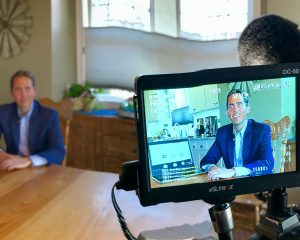Apr 3, 2020 | Uncategorized

Virtual events are quickly becoming a popular tool for many nonprofits. Fladeboe Advancement has developed the best practices in virtual event fundraising and is helping a wide range of nonprofit organizations create a successful virtual event.
In this KARE 11 news feature, watch Glen Fladeboe, Principal Partner at Fladeboe Advancement, explain how one organization quickly – and successfully – made the change.
Mar 12, 2020 | Uncategorized
Today we are sharing the action steps Fladeboe Advancement is taking in response to the coronavirus (COVID-19) and the potential impact to our clients and their special events.
First, we are continuing to plan that events will happen over the coming weeks and months. We, like all of you, will look to the recommendations of state and national health professionals to guide decisions regarding postponing or canceling.
If events do need to be cancelled, we recommend our spring 2020 clients reschedule their event for a weeknight date this summer. Fladeboe Advancement will not be charging a cancellation fee to clients rescheduling an event.
Our team will guide our clients on effective strategies to engage donors in a mission-based (fund-a-need) online giving campaign. Organizations will be able to utilize their current online or mobile giving platform (such as Auction Harmony, OneCause, GiveSmart or Greater Giving). For organizations deciding to have a virtual event, our contract agreement will remain in effect.
In addition, Fladeboe Advancement will assist clients with key strategies to market live auction items through an online auction format, enhancing the return and value of these items.
It is our sincere hope that events can continue in the coming weeks and months. That said, we stand ready and committed to proactively assist you in every way to address this challenge and provide smart, actionable and mission-based solutions to ensure the financial well-being of your organization. Finally, we believe the right strategies used in this moment will rally and motivate donors during this time of need.
For a consultation about conducting a virtual event, or to inquire about rescheduling your event on a new date, please contact one of our team members listed below.
Sincerely,
Glen Fladeboe
Kristin Kroll, Kristin@FladeboeAdvancement.com
Paula Werner, Paula@FladeboeAdvancement.com
Kristine Fladeboe-Duininck, Kristine@FladeboeAdvancement.com
Kate Pearce, Kate@FladeboeAdvancement.com
Stacey McCurnin, Stacey@FladeboeAdvancement.com
Dec 5, 2019 | Uncategorized

Glen Fladeboe, Angela Davis and Sara Lueben at MPR
What is the most powerful tool in an event fundraiser’s tool box? How are younger donors participating in giving?
Glen Fladeboe, Principal Partner of Fladeboe Advancement, and Sara Lueben, Grantmaking Chair at Fourth Generation and the Community Engagement Coordinator at NorthPoint Health and Wellness Center, Inc., sat down with Angela Davis of Minnesota Public Radio (MPR) News to discuss fundraising strategies and how giving is changing in the Twin Cities and beyond. Glen shares insights and stories from recent charity gala events and Sara shares how Millennials through Generation-X are getting involved in giving.
Listen here to learn more about the strong culture of giving in Minnesota and how the actions of one will influence others.
Aug 7, 2019 | Uncategorized

In Part II of this article series, we continue looking at insights from Giving USA 2019, a study of US charitable giving in 2018. (Read Part I.)
1. What you heard: Nine of eleven recipient sub-sectors saw giving fall or stay flat.
What you might not have heard: The two sub-sectors with growth (International Affairs and Environment/Animals) also have the highest percentage of online giving. Some speculate an embrace of technology is one factor in the growth. It can make giving easier, appeal to a younger set of donors, and allow a nonprofit to be nimble in its fundraising.
Our tip: Evaluate the “journey” your donors take in making a gift, especially online. Is the process easy? Do donors feel appreciated? Do you report back on outcomes?
2. What you heard: Giving as a percentage of GDP (gross domestic product) remained flat at 2.1%. It has hovered around 2% for more than 20 years.
What you might not have heard: Giving as a percentage of disposable personal income (DPI) also remained flat (1.9%) even though DPI increased by 5% in 2018. The share of wallet for “traditional” charitable giving (to a 501(c)3) isn’t going
up even with more in our wallets. This may signal a change in how Americans view “giving.”
Our tip: Donor stewardship must be a top priority for nonprofits. Donors could spend their disposable income on any number of things, and they choose your organization. Show them you are truly grateful and they are making a difference.
3. What you heard: The fundraising landscape is changing.
What you might not have heard: Some things we can’t control, but we can keep up with changes to ensure giving stays strong.
Our tips:
-
-
-
- Focus on retention! With fewer households giving, acquisition is more challenging. Building relationships is always a solid strategy.
- Talk to donors about how policy is affecting them – don’t assume you know.
- Use strategies such as recurring giving to diversify revenue streams. Build a pipeline for the future by engaging younger donors, even if they aren’t giving yet.
- Continue to study trends in giving, such as demographic shifts, changes in giving strategies and vehicles, and the influence of technology. Adapt your fundraising accordingly.
Jul 17, 2019 | Uncategorized

Topline findings from Giving USA 2019, a study of 2018 charitable giving in the US, have been reported extensively over the past several weeks. Yet the study reveals quite a bit more when you look a little deeper. We’ve been scouring the full report and following the commentary, and will be sharing a few interesting things we’ve learned over the next few weeks.
1. What you heard: Americans gave $427.71B in 2018, up .7% compared with 2017 (current dollars, or down 1.7% adjusted for inflation).
What you might not have heard: The sky is not falling. Though such a slight increase in giving sounds worrisome, 2018 was the second-highest giving total EVER, following a record-breaking 2017. Giving has grown steadily since the end of the recession, and it’s not uncommon to level-off after a long growth period.
Our tip: Spend some time looking at your numbers. Do they follow the trends? Knowing where you are allows you to better strategize for the future.
2. What you heard: 2018 was a complex year in fundraising, with economic conditions and the policy environment influencing giving behaviors.
What you might not have heard: The true effects of economics and policy (especially the Tax Cuts and Jobs Act of 2017) are not known (yet). The numbers just haven’t been collected and analyzed (yet), though a lot of anecdotal evidence and estimates exist. There was and will continue to be an effect; we just won’t understand it fully for a while longer.
Our tip: Continuing to invest in retaining donors is always a good strategy. Strong relationships can help nonprofits weather the changes in economics and policy.
3. What you heard: Giving from living individuals as a percentage of total giving fell below 70% (to 68%) for the first time since at least 1954. Making up the rest of the pie: Foundations (18%, up), Bequests (9%, flat), and Corporations (5%, up).
What you might not have heard: Individual giving is still over 80% if bequests, family foundations and donor advised funds are part of the individual bucket. Individual giving still makes up the bulk of charitable giving in the United States, though the “how” of this giving is seeing significant changes.
Our tip: Understand and build multiple means for giving into your fundraising program. No matter how a donor gives, make sure they are thanked and feel appreciation.
Watch for our next post soon with more of what we’ve learned!




